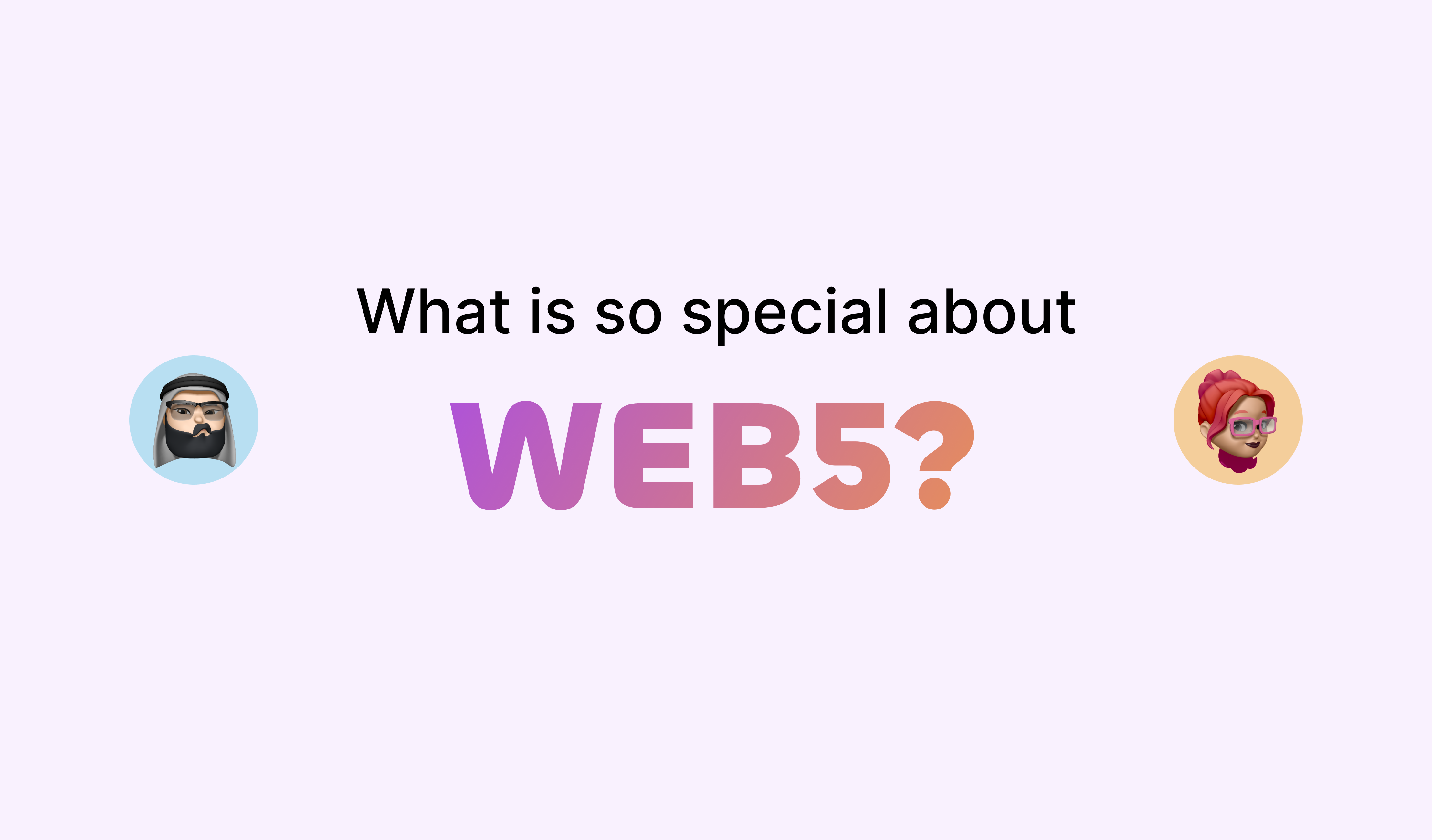What is so special about Web5?
 Isaac Oluwarotimi
Isaac Oluwarotimi
Introduction
I know you are wondering how fast the world is revolving and if you can ever catch up. The world is still trying to wrap its head around Web3, which was referred to as the next iteration of the internet that promotes decentralized protocols and aims to reduce dependency on large tech companies like Facebook, Amazon, and Google.
Boom! Web5. Another web behemoth with so many promises was introduced by Jack Dorsey, the creator of the Web2 platform, Twitter. He plans to build a new decentralized web centered around Bitcoin (BTC), and this largest blockchain network will play a major role in the internet’s evolution.
Evolution of the web
Web 1.0: static, read-only content
Web 2.0: interactive, social, and user-generated content
Web3: Decentralized, blockchain-based, user-controlled data
Web5: Enhanced decentralization, peer-to-peer communication, and self-sovereign identity
What is Web5, and what makes it so special?
Web5 is a decentralized platform that provides a new identity layer for the web to enable decentralized apps and protocols. It enables developers to leverage decentralized identities, verifiable credentials, and decentralized web nodes to bring decentralized identity and data storage to their applications. It also creates an atmosphere for developers to focus on creating delightful user experiences while returning ownership of data and identity to individuals.
Web5 aims for an emotional, human-like interface to enhance user engagement, build trust, and create a more intuitive and enjoyable interaction while giving the user full control. Functioning as a peer-to-peer trust mechanism built on top of Bitcoin blockchain infrastructure, Web5 is detached from any base blockchain network and operates completely through decentralized web nodes.
One of the possibilities is that Web5 provides guaranteed portability for personal identity.
Pillars and components of Web5
Presently, the architecture and backend functionality of Web5 and Web3 differ greatly. Even though Web5 is still in its early phases, it is critical to investigate the frameworks and protocols that it is based on and compare them to Web3. Let's take a look at Web5's core pillars:
Decentralized identifiers (DIDs)
Verifiable credentials (VCs)
Decentralized web applications (DWAs)
Decentralized web nodes (DWNs)
Self-sovereign Identity standard (SSIS)
Self-sovereign identity SDK (SSI SDK)
Decentralized identifiers (DIDs)
Web5 is supposed to work through decentralized identifiers (DIDs), which are unique identifiers that are generated and controlled by users. As a result, web consumers retain full control over their property. And the data they share. However, that’s not all. DIDs are perfect for creating so-called self-sovereign, fully decentralized identities. In contrast to centralized intermediary identifiers such as emails and phone numbers, which are siloed within each ecosystem, users can control how their identities and personal information are used, shared, and accessed.
The unique identifier of users will be connected to their data via the Decentralized Web Node (DWN). Hence, users' data is isolated from centralized storage, giving users complete control over their data, and developers will be able to focus on creating the best user experience possible without having to worry about storage. Some of its features are DID anchoring, key rolling, linking multiple keys, multiple key types, and the DID SDK for wallets.
Verifiable credentials (VCs)
These are tamper-evident, cryptographically-enabled digital credentials. They are secure and impossible to forge without proof that they’ve been tampered with. They prove a user’s identity, similar to a national ID, student ID, international passport, driver’s license, etc.
Verifiable credentials are an international standard for creating independently verifiable sets of claims from one or more individuals or entities about others. Some of its features are Basic Credentials zero-knowledge-proof (ZKP) credentials, credential revocation, credential templates, custom issuer logic, and an issuer console.
Decentralized web nodes (DWNs)
An application that runs software protocols to allow nodes, and therefore Web5 users, to interface and share data. In a fully decentralized web, nodes communicate and work together to host and share web content between users and participants without needing a central authority or organization to control it. Some of its features are data storage, protocols, sync, propagation, permissions, and encryption.
DWNs are a crucial part of Web5; they are the distributed networks used by Web5 users to host and serve content to all users via peer-to-peer (P2P) protocols. They serve as data storage and the message-relaying mechanism that enables Web5 users to communicate, share, and identify information among one another.
Decentralized web applications (DWAs)
DWAs can be called decentralized “progressive web apps.” Social media platforms like Twitter, Facebook, Telegram, etc., commonly use Progressive Web Apps (PWAs). They are website versions of native apps and rely on web browsers that support the necessary web technologies. Typically, they include most, if not all, of the features found in native apps. They can effortlessly operate as native apps, and some are also installable from app stores. We can describe PWA as a “hybrid” between websites and mobile applications in lay language. Some of DWA's features are the Web5 SDK, the DWA app model, the Web5.connect() support, and the quickstart app template.
Self-sovereign Identity standard (SSIS)
SSIS is a decentralized identity management service that enables individuals and organizations to control their own digital identities This mechanism interacts with verifiable credentials (VCs) by creating, signing, curating, issuing, validating, and verifying them. It basically works with the SSI SDK
It is built on blockchain platforms that maximize smart contracts to provide a secure, decentralized, and tamper-proof way to manage digital identities.
Self-sovereign identity SDK (SSI SDK)
The SSI SDK contains SSIS, and it aims to provide flexible functionality based on set standards for building identity apps in a modular way with limited dependencies between components. It has standards-based primitives for using DIDs and VNs
It is designed to handle the full VCs lifecycle, including assurance, verification, and revocation, and works with any identity management system (IMS), providing a set of tools and APIs to allow developers to easily build apps that utilize SSI principles and give users complete control over their data.
Use cases of web5
TBD seems to agree. Using the example of a persona called Bob, who is a music lover, they explain that "there's a way out of vendor-locked silos. Bob can keep this data on his decentralized web node. This way, Bob can grant any music app access to his settings and preferences, enabling him to take his personalized music experience wherever he chooses. Therefore, Web5 will give users full ownership and control of their data.” Something that TBD seems to think will not be delivered by a VC-backed Web3 model, as they see it.
Web3 vs Web5
In our opinion, the two concepts cannot be compared to each other. Web3 is mainly a smart contract that is implemented on public blockchains (e.g., Ethereum). In the crypto world, this branch of the internet is often compared to dApps.
Web5 focuses mainly on decentralized web applications (DWAs). These are not blockchain-based. As a result, here we have a peer-to-peer network that exists independently.
What is the other difference? Web5 ensures that the user will have full control over their data, which they store in the DWN. Web3 stores this data on a decentralized network or distributed file system with IPFS.
When will Web5 be available?
I know that after being so enlightened on the topic of Web5, you are probably asking the same questions as everyone: when would this web launch?
Well, a fully working Web5 is still years away, according to the consensus. Dorsey and his team have disclosed their intentions in their TBD roadmap to create a public beta platform by Q4 of 2023.
For the general public, it’s going to be very hard to say specifically the launch date as it's a work in progress and requires several companies, organizations, and members of the public to grow the Bitcoin-embedded internet layer over the next few years.
Conclusion
The internet was invented more than three decades ago. Numerous innovations have occurred as a result of the web, but privacy remains a source of debate. The issue of privacy is so significant that legislators have been focusing on it with rules and legislation
Without legislation, Web5 appears to be the only web with a real decentralized architecture. In terms of real decentralization, it addresses privacy concerns, offers users authority over data, and shifts the burden of data collection on companies, with customers having the freedom to reject.
And for that reason, whatever Web5 is fully revealed to be, for that matter, we are on course for a new and special identity system unlike anything we’ve ever seen before.
Subscribe to my newsletter
Read articles from Isaac Oluwarotimi directly inside your inbox. Subscribe to the newsletter, and don't miss out.
Written by
